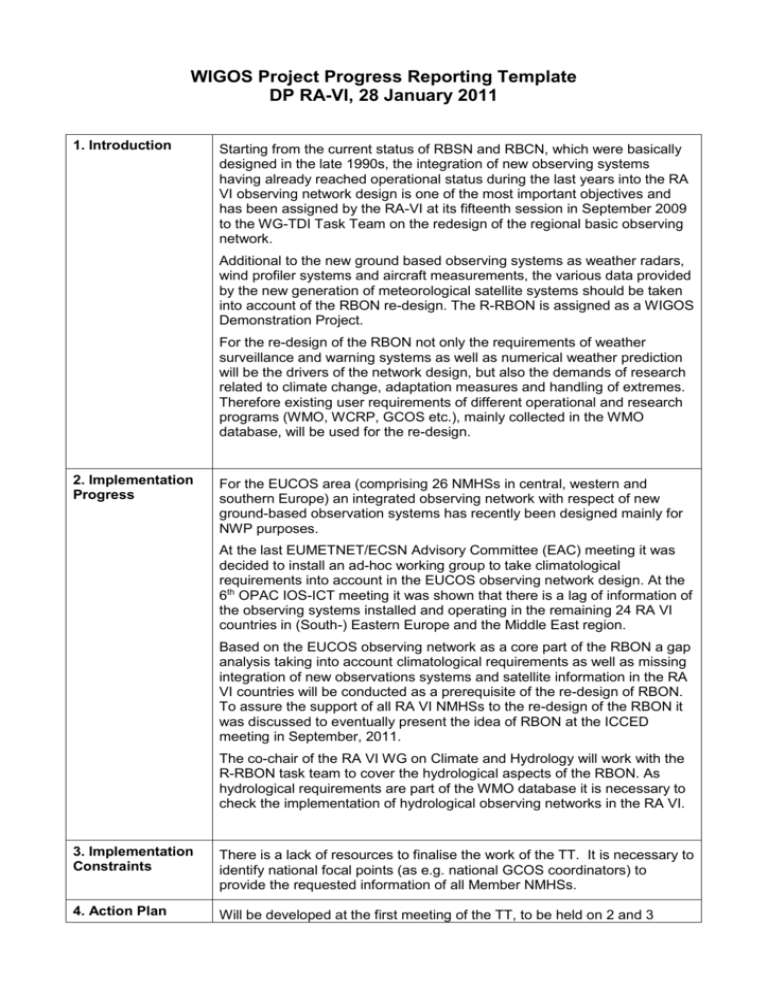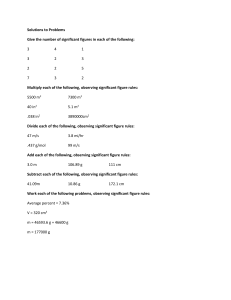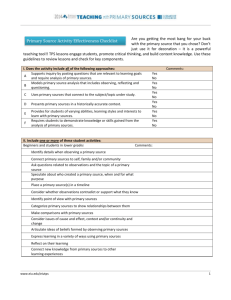Prog_Rep
advertisement

WIGOS Project Progress Reporting Template DP RA-VI, 28 January 2011 1. Introduction Starting from the current status of RBSN and RBCN, which were basically designed in the late 1990s, the integration of new observing systems having already reached operational status during the last years into the RA VI observing network design is one of the most important objectives and has been assigned by the RA-VI at its fifteenth session in September 2009 to the WG-TDI Task Team on the redesign of the regional basic observing network. Additional to the new ground based observing systems as weather radars, wind profiler systems and aircraft measurements, the various data provided by the new generation of meteorological satellite systems should be taken into account of the RBON re-design. The R-RBON is assigned as a WIGOS Demonstration Project. For the re-design of the RBON not only the requirements of weather surveillance and warning systems as well as numerical weather prediction will be the drivers of the network design, but also the demands of research related to climate change, adaptation measures and handling of extremes. Therefore existing user requirements of different operational and research programs (WMO, WCRP, GCOS etc.), mainly collected in the WMO database, will be used for the re-design. 2. Implementation Progress For the EUCOS area (comprising 26 NMHSs in central, western and southern Europe) an integrated observing network with respect of new ground-based observation systems has recently been designed mainly for NWP purposes. At the last EUMETNET/ECSN Advisory Committee (EAC) meeting it was decided to install an ad-hoc working group to take climatological requirements into account in the EUCOS observing network design. At the 6th OPAC IOS-ICT meeting it was shown that there is a lag of information of the observing systems installed and operating in the remaining 24 RA VI countries in (South-) Eastern Europe and the Middle East region. Based on the EUCOS observing network as a core part of the RBON a gap analysis taking into account climatological requirements as well as missing integration of new observations systems and satellite information in the RA VI countries will be conducted as a prerequisite of the re-design of RBON. To assure the support of all RA VI NMHSs to the re-design of the RBON it was discussed to eventually present the idea of RBON at the ICCED meeting in September, 2011. The co-chair of the RA VI WG on Climate and Hydrology will work with the R-RBON task team to cover the hydrological aspects of the RBON. As hydrological requirements are part of the WMO database it is necessary to check the implementation of hydrological observing networks in the RA VI. 3. Implementation Constraints There is a lack of resources to finalise the work of the TT. It is necessary to identify national focal points (as e.g. national GCOS coordinators) to provide the requested information of all Member NMHSs. 4. Action Plan Will be developed at the first meeting of the TT, to be held on 2 and 3 -2February 2011 in Offenbach, Germany. 5. Lessons Learned 6. Challenges 7. Implementation Priorities for the next period 8. Resources Status 9. Project Focal Point Not yet applicable. To manage the resource problem. First Meeting of the TT on R-RBON: Review the existing requirements of the different areas of application by TT Members. June 2011 Develop criteria for an integrated observing network for the whole RA VI based on EUCOS experiences. August 2011 Conduct an analysis of existing observing systems and significant gaps related to the requirements. October 2011 Integrate climatological and hydrological requirements into the network design Take into account operational satellite data for the design of a ground-based network. End of 2011 Klaus-Jürgen Schreiber, TT-Leader Deutscher Wetterdienst Head Climate Monitoring Department Frankfurter Str. 135 63067 Offenbach Germany Email: Klaus-Juergen.Schreiber@dwd.de 10. Place and Date Offenbach, 28 January 2011 Feb./Mar 2011








